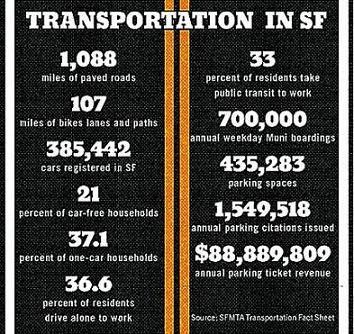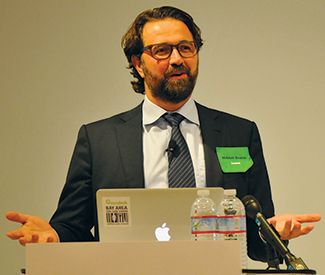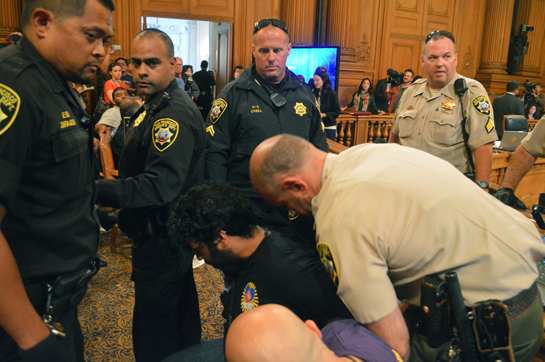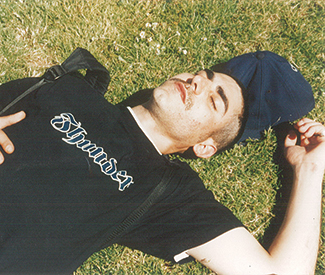Stage listings are compiled by Guardian staff. Performance times may change; call venues to confirm. Reviewers are Robert Avila, Rita Felciano, and Nicole Gluckstern. Submit items for the listings at listings@sfbg.com.
THEATER
OPENING
“Bay Area Playwrights Festival” Thick House Theater, 1695 18th St, SF; www.playwrightsfoundation.org. $15. Runs Fri/18-Sun/20 and July 25-27. The Playwrights Foundation’s 37th annual festival of new plays contains six new works; authors include Rob Melrose, Elizabeth Hersh, Phillip Howze, and E. Hunter Spreen.
Everybody Here Says Hello! and Superheroes Exit Theatre, 156 Eddy, SF; www.wilywestproductions.com. $22-35. Runs July 17-23. Wily West Productions presents two world premiere plays in repertory; Hello! is by Stuart Bousel, while Superheroes is a collaborative effort by eight local writers.
Patterns Dennis Gallagher Arts Pavilion (in the French American International High School), 66 Page, SF; www.thenewstage.com. $30. Opens Wed/16, 8pm. Runs Wed-Sat, 8pm. Through Aug 16. Performance artist Amy Munz performs her solo show, a multimedia exploration of different questions about love.
The Scion Marsh San Francisco, 1062 Valencia, SF; www.themarsh.org.$30-100. Opens Sat/19, 5pm. Runs Sat, 5pm. Through Aug 23. Brian Copeland’s hit solo show, “a tale of privilege, murder, and sausage,” returns to the Marsh.
Sweet Maladies Brava Theater Center, 2781 24th St, SF; www.brava.org. $15. Opens Fri/18, 8pm. Runs Thu-Sat, 8pm; Sun, 3pm. Through Aug 3. Brava! For Women in the Arts, Black Artist Contemporary Cultural Exchange, and director Edris Cooper-Anifowoshe present Zakiyyah Alexander’s drama, set just after the end of slavery in America and based on Jean Genet’s The Maids.
BAY AREA
Old Money Barn Theatre, 30 Sir Francis Drake, Ross; www.rossvalleyplayers.com. $10-26. Previews Thu/17, 7:30pm. Opens Fri/18, 8pm. Runs Thu, 7:30pm; Fri-Sat, 8pm; Sun, 2pm (no show Sun/20). Through Aug 17. Ross Valley Players performs Wendy Wasserstein’s New York City-set comedy.
Romeo and Juliet Forest Meadows Amphitheater, 890 Belle, Dominican University of California, San Rafael; www.marinshakespeare.org. $12-35. Opens Fri/18, 8pm. Runs in repertory Fri-Sun through Sept 28; visit website for specific performance dates and times. Marin Shakespeare continues its 25th season with the Bard’s timeless tragedy.
ONGOING
Each and Every Thing Marsh San Francisco Main Stage, 1062 Valencia, SF; www.themarsh.org. $20-50. Thu-Fri, 8pm; Sat, 8:30pm. Extended through Aug 24. The latest solo show from celebrated writer-performer Dan Hoyle (Tings Dey Happen, The Real Americans) winds a more random course than usual across the country and abroad but then that’s the idea — or at least Hoyle warns us, right after an opening encounter with a touchy young white supremacist, that the trip he’s taking us on is a subtle one. Displaying again his exceptional gifts as a writer and protean performer, Hoyle deftly embodies a set of real-life encounters as a means of exploring the primacy and predicament of face-to-face communication in the age of Facebook. With the help of director Charlie Varon (who co-developed the piece with Hoyle and Maureen Towey), this comes across in an entertaining and swift-flowing 75-minute act that includes a witty rap about “phone zombies” and a Dylan-esque screed at a digital detox center. But the purported subject of connection, or lack there of, in our gadget-bound and atomized society is neither very original nor very deeply explored — nor is it necessarily very provocative in a theater, before an audience already primed for the live encounter. Far more interesting and central here is Hoyle’s relationship with his old college buddy Pratim, an Indian American in post-9/11 America whose words are filled with laid-back wisdom and wry humor. Also intriguing is the passing glimpse of early family life in the Hoyle household with Dan’s celebrated artist father, and working-class socialist, Geoff Hoyle. These relationships, rather than the sketches of strangers (albeit very graceful ones), seem the worthier subjects to mine for truth and meaning. Indeed, there’s a line spoken by Pratim that could sum up the essence of Hoyle’s particular art: “It’s so much better,” he says, “when you find yourself in other people than when you just find yourself.” Hoyle’s real frontier could end up being much more personal terrain, much closer to home. (Avila)
Foodies! The Musical Shelton Theater, 533 Sutter, SF; www.foodiesthemusical.com. $32-34. Fri-Sat, 8pm. Open-ended. AWAT Productions presents Morris Bobrow’s musical comedy revue all about food.
“Fury Factory” Z Space, 450 Florida, SF; Z Below, 470 Florida, SF; Joe Goode Annex, 401 Alabama, SF; NOHspace, 2840 Mariposa, SF; www.foolsfury.org. $16 (three performances, $39; five performances, $55). Through Sun/20. Festival of ensemble theater with works by Dandelion Dancetheatre, Dzieci Theatre, Epic Frame, Post Natyam Collective, Teatro Luna, the Imaginists, and others.
God Fights the Plague Marsh San Francisco Studio Theater, 1062 Valencia, SF; www.themarsh.org. $15-100. Sat, 8:30pm; Sun, 7pm. Through Aug 10. The Marsh presents a solo show written by and starring 18-year-old theater phenom Dezi Gallegos.
The Guerrillas of Powell Street Bindlestiff Studio, 185 Sixth St, SF; www.bindlestiffstudio.org. $10-20. Fri-Sat, 8pm; Sun, 3pm. Through Aug 2. Bindlestiff Studio presents the world premiere of the English translation of Rody Vera’s play about Filipino World War II veterans in San Francisco, based on Benjamin Pimentel’s novel.
Hick: A Love Story, The Romance of Lorena Hickok and Eleanor Roosevelt Eureka Theatre, 215 Jackson, SF; www.crackpotcrones.com. Free. Thu-Sat, 8pm; Sun, 3pm. Through July 27. Crackpot Crones and Theatre Rhinoceros present Terry Baum in her new solo show about the relationship between the pioneering journalist and the First Lady.
Into the Woods San Francisco Playhouse, 450 Post, SF; www.sfplayhouse.org. $20-120. Tue-Thu, 7pm; Fri-Sat, 8pm (also Sat, 3pm); Sun, 2pm. Through Sept 6. SF Playhouse performs Stephen Sondheim’s fractured fairy-tale musical.
Life X 3 Phoenix Theatre, 414 Mason, Ste 601, SF; www.offbroadwaywest.org. $40. Thu/17-Sat/19, 8pm. Off Broadway West Theatre Company performs Yasmina Reza’s comedy, set at a disastrous Parisian dinner party. Translation is by Christopher Hampton.
Now and at the Hour Exit Theatre, 156 Eddy, SF; www.theexit.org. $15-25. Fri-Sat, 8pm. Through July 26. Magician and solo performer Christian Cagigal performs his latest show, “an intimate, interactive, and unnerving theatrical experience.”
Pearls Over Shanghai Hypnodrome Theatre, 575 10th St, SF; www.thrillpeddlers.com. $30-35. Thu-Sat, 8pm. Extended through July 26. Five years ago, Thrillpeddlers breathed new life into a glitter-dusted piece of Sixties flotsam, beautifully reimagining the Cockettes’ raunchy mock-operetta Pearls Over Shanghai (in collaboration with several surviving members of San Francisco’s storied acid-drag troupe) and running it for a whopping 22 months. Written by Cockette Link Martin as a carefree interpretation of a 1926 Broadway play, the baldly stereotyped Shanghai Gesture, it was the perfectly lurid vehicle for irreverence in all directions. It’s back in this revival, once again helmed by artistic director Russell Blackwood with musical direction by Cockette and local favorite Scrumbly Koldewyn. But despite the frisson of featuring some original-original cast members — including “Sweet Pam” Tent (who with Koldewyn also contributes some new dialogue) and Rumi Missabu (regally reprising the role of Madam Gin Sling) — there’s less fire the second time around as the production straddles the line between carefully slick and appropriately sloppy. Nevertheless, there are some fine musical numbers and moments throughout. Among these, Zelda Koznofsky, Birdie-Bob Watt, and Jesse Cortez consistently hit high notes as the singing Andrews Sisters-like trio of Americans thrown into white slavery; Bonni Suval’s Lottie Wu is a fierce vixen; and Noah Haydon (as the sultry Petrushka) is a class act. Koldewyn’s musical direction and piano accompaniment, meanwhile, provide strong and sure momentum as well as exquisite atmosphere. (Avila)
Shit & Champagne Rebel, 1772 Market, SF; shitandchampagne.eventbrite.com. $25. Fri-Sat, 8pm. Open-ended. D’Arcy Drollinger is Champagne White, bodacious blond innocent with a wicked left hook in this cross-dressing ’70s-style white-sploitation flick, played out live on Rebel’s intimate but action-packed barroom stage. Written by Drollinger and co-directed with Laurie Bushman (with high-flying choreography by John Paolillo, Drollinger, and Matthew Martin), this high-octane camp send-up of a favored formula comes dependably stocked with stock characters and delightfully protracted by a convoluted plot (involving, among other things, a certain street drug that’s triggered an epidemic of poopy pants) — all of it played to the hilt by an excellent cast that includes Martin as Dixie Stampede, an evil corporate dominatrix at the head of some sinister front for world domination called Mal*Wart; Alex Brown as Detective Jack Hammer, rough-hewn cop on the case and ambivalent love interest; Rotimi Agbabiaka as Sergio, gay Puerto Rican impresario and confidante; Steven Lemay as Brandy, high-end calf model and Champagne’s (much) beloved roommate; and Nancy French as Rod, Champagne’s doomed fiancé. Sprawling often literally across two buxom acts, the show maintains admirable consistency: The energy never flags and the brow stays decidedly low. (Avila)
Too Much Light Makes the Baby Go Blind Boxcar Theatre, 505 Natoma, SF; www.sfneofuturists.com. $11-16. Fri-Sat, 9pm. Ongoing. The Neo-Futurists perform Greg Allen’s spontaneous, ever-changing show that crams 30 plays into 60 minutes.
BAY AREA
American Buffalo Aurora Theatre, 2081 Addison, Berk; www.auroratheatre.org. $32-60. Wed/16-Sat/19, 8pm; Sun/20, 2 and 7pm. It’s hard to shake the feeling, while watching Aurora Theatre’s current production, that David Mamet’s name-making 1975 play, about three smalltime crooks in a Chicago junk shop, remains his best. Its lean two-act structure, the precise nonsense of its streetwise cant, and the wonderfully layered themes of loyalty, family, and tradition among a society of cannibals all come together in a feint of a plot about a heist to retrieve a certain buffalo nickel. Barbara Damashek directs a powerhouse trio of actors in the effort: a stoical but vaguely looming Paul Vincent O’Connor as Donny, the shop’s owner; a sure and affecting Rafael Jordon as his half-addled young protégé Bobby; and a wired, wiry James Carpenter as Teach, the reckless loudmouth who stirs up the pot with disastrous consequences. While the first act feels a little careful in its unfolding, the second act develops grippingly, and overall the production conveys the nuances of Mamet’s precise language, coiled humor, and familial drama with elegant precision. (Avila)
As You Like It Forest Meadows Amphitheater, 890 Belle, Dominican University of California, San Rafael; www.marinshakespeare.org. Donations accepted. Runs in repertory Fri-Sun through Aug 10; visit website for specific performance dates and times. It’s outdoor Shakespeare season in the Bay Area! Marin Shakespeare kicks off its 25th season with a classic production of the Bard’s gender-bending comedy.
Dracula Inquest Berkeley City Club, 2315 Durant, Berk; www.centralworks.org. $15-28. Thu-Sat, 8pm; Sun, 5pm. Through Aug 17. Central Works performs Gary Graves’ mystery inspired by the Bram Stoker vampire classic.
The Great Pretender Lucie Stern Theatre, 1305 Middlefield, Palo Alto; www.theatreworks.org. $19-74. Tue-Wed, 7:30pm; Thu-Sat, 8pm (also Sat, 2pm); Sun, 2 and 7pm. Through Aug 3. TheatreWorks performs the world premiere of David West Read’s bittersweet comedy.
Nantucket Marsh Berkeley MainStage, 2120 Allston, Berk; www.themarsh.org. $25-100 (all tickets include a picnic dinner). Thu/17 and Sat/19, 7pm. Nantucket Island, a wisp of shifting sand 30 miles off the coast of Cape Cod, Mass., is the evocative setting for this autobiographical story from writer-performer Mark Kenward — less the tourists’ Nantucket of summer holidays, mind you, than the inhabitants’ gray and isolated winter. And just as its bleak weather stood for the tempestuous mood of Herman Melville’s Ishmael before he sets sail again in Moby Dick, so the environment for Kenward’s coming-of-age darkly foreshadows a terrible downward spiral. The only son and oldest child of two in a nuclear family from Normal, Ill., that really seemed to fit the bill — complete with a dad who, “in his entire life, only missed four days of shaving” — Mark becomes the odd-boy out upon the Kenwards’ relocation to the remote island. An affable, poised, physically demonstrative performer with a residual Midwestern charm, Kenward describes an upbringing in a household overshadowed by a high-strung, controlling, deeply unhappy mother who, as luck would have it, also becomes his high school English teacher. This relationship is the ground for much of the play’s humor, but also a trauma that blows in like a winter squall. Directed keenly, if perhaps a little too stiffly, by Rebecca Fisher, and accompanied at points by a watery island backdrop (courtesy of video designer Alfonso Alvarez), Nantucket discharges some of its messy human themes a bit too neatly but maintains an inescapable pull. (Avila)
Pride and Prejudice John Hinkel Park Amphitheatre, 41 Somerset, Berk; www.aeofberkeley.org. Free. Sat/19-Sun/20, 4pm. Actors Ensemble of Berkeley performs Constance Cox’s adaptation of the Jane Austen novel.
Purlie Malonga Casquelourd Center for the Arts, 1428 Alice, Oakl; www.cityfideentertainment.com. $35-45. Thu/17-Sat/19, 7pm (also Sat/19, 3pm); Sun/20, 3pm. 100% Cityfide Entertainment performs Ossie Davis’ play — with new scenes by director Li’J. Smith — about an African American preacher in the Jim Crow-era South.
The Ripple Effect This week: Arena Theater, 214 Main, Point Arena; www.sfmt.org. $10-30. Wed/16, 8pm. Also Thu/17, 7pm, Todd Grove Park, Live Oak at Clubhouse, Ukiah. Free (donations accepted). Also Sat/19, 8pm, Mateel Community Center, 59 Rusk, Redway. $18-20. Continues through Sept 1 at various NorCal venues. The veteran San Francisco Mime Troupe stays current by skewering San Francisco’s ever-dividing economy; think rising rents, tech-bus protests, and (natch) Glassholes.
Shrek the Musical Julia Morgan Theatre, 2640 College, Berk; www.berkeleyplayhouse.org. $17-60. Sat, 1 and 6pm; Sun, noon and 5pm; July 22-23 and 30-31, 7pm (also July 22-23, 3:30pm). Through Aug 3. Berkeley Playhouse performs the musical based on the DreamWorks fairy tale film.
“Splathouse Double Feature” La Val’s Subterranean, 1834 Euclid, Berk; http://impacttheatre.com. $10-25. Thu-Sat, 8pm. Through Aug 9. Impact Theatre performs The Sadist and Eegah!, film and live performance blends inspired by the classic exploitation movies.
The Taming of the Shrew This week: Memorial Park Amphitheater, Stevens Creek at Mary, Cupertino; www.sfshakes.org. Free. Sat/19-Sun/20, July 25-27, Aug 1-3, 7:30pm. Continues through Sept 21 at various Bay Area venues. Free Shakespeare in the Park presents this take on the Bard’s barb-filled romance.
12th Night Ashby Stage, 1901 Ashby, Berk; www.shotgunplayers.org. $20-35. Wed-Thu, 7pm; Fri-Sat, 8pm; Sun, 5pm. Through Aug 17. Shotgun Players take a fresh approach to the Shakespeare classic, using folk music and other twists.
PERFORMANCE/DANCE
“Canciones del Mar: Songs of the Sea” Hyde Street Pier, 2905 Hyde, SF; www.weplayers.org. Sat/19, 6-8pm. $12-40. We Players presents this night of folkloric music from Latin America and the Caribbean aboard the tall ship Balclutha.
Caroline Lugo and Carolé Acuña’s Ballet Flamenco Peña Pachamama, 1630 Powell, SF; www.carolinalugo.com. Sat/19 and July 27, 6:30pm. $15-19. Flamenco performance by the mother-daughter dance company, featuring live musicians.
“Cynic Cave” Lost Weekend Video, 1034 Valencia, SF; lostweekendcinecave.eventbrite.com. Sat/19, 8 and 10pm. $12. Stand-up with Matt Ingebretson and Anna Seregina.
“Dash: Improv in a Flash” Un-Scripted Theater Company, 533 Sutter, Second Flr, SF; www.un-scripted.com. Sat, 10pm. $15. Ongoing through Aug 30. A late-night, free-form improv show with Un-Scripted Theater Company.
“Field Notes: Doing Time in Education” Yerba Buena Center for the Arts Theater, 700 Howard, SF; www.ybca.org. Thu/17, 7pm. $15. Award-winning actor, playwright, and educator Anna Deavere Smith performs a staged reading of her work-in-progress, comprised of interviews conducted with individuals affected by the “school-to-prison pipeline” in Northern California. Jazz musician Marcus Shelby also performs.
“Forbidden Broadway: Alive and Kicking!” Feinstein’s at the Nikko, 222 Mason, SF; www.feinsteinssf.com. Thu-Fri, 8pm; Sat-Sun, 7pm. Through July 27. $45-60. Anyone who’s ever put palm to forehead and groaned under the banal grandiosity and shameless cunning of a Broadway show should get at least a couple of satisfying yucks out of Forbidden Broadway, writer-director Gerard Alessandrini’s long-running, multi-edition musical sendup, now at Feinstein’s at the Nikko for a limited run. It’s ultimately a Broadway lover’s dish, of course, since who can dish and cavil about such minutiae of the Broadway season as Idina Menzel’s ear-splitting vocal style without the ardor of a partisan? Four able cast members — Susanne Blakeslee, James Donegan, Gina Kreiezmar, and William Selby (all veterans of other Forbidden Broadway runs) — dole out 75-minutes worth of hit-and-miss spoofs (propelled by musical director Catherine Stornetta’s vigorous piano accompaniment) about everything from the inevitable return of Les Miz to the vaporous and vapid storytelling of Jersey Boys, with a good number of barbs reserved for contemporary Broadway’s commercially safe, lucrative, and cheap-ass recycling of stories and songs. It’s a lean show, though wacky costumes and cringing puns abound, and while rarely dazzling a show this unrestrainedly goofy begins to acquire a cumulative, surreal potency — and anyway Kreiezmar’s Liza Minnelli is something to behold. (Avila)
“Love Balm for My SpiritChild” Brava Theater Center, 2781 24th St, SF; www.brava.org. Fri/18-Sat/19, 8pm; Sun/20, 3pm. $10-25. Brava! For Women in the Arts and Arielle Julia Brown’s Love Balm Project present this choreo-play based on testimonies from Bay Area mothers who have lost children to gun violence.
“Magic at the Rex” Hotel Rex, 562 Sutter, SF; www.magicattherex.com. Sat, 8pm. Ongoing. $25. Magic and mystery with Adam Sachs and mentalist Sebastian Boswell III.
“The Merry Widow” Legion of Honor, 100 34th Ave, SF; www.pocketopera.org. Sun/20, 2pm. $39-42. Also July 27, 2pm, Hillside Club, 2286 Cedar, Berk. Pocket Opera performs the Franz Lehár classic.
“Out of Line Improv” Stage Werx, 446 Valencia, SF; outoflineimprov.brownpapertickets.com. Sat, 10:30pm. $12. Ongoing. A new, completely improvised show every week.
“Partyiac Arrest: American Dream — Past, Present, Future (Perfect)” Mojo Theatre, 2940 16th St, #217, SF; www.mojotheatre.com. Thu/17-Sat/19, 8pm. $15-50. Variety show cabaret with sketch comedy, music, clowning, dance, and more.
“People in Plazas” Various locations, SF; www.peopleinplazas.org. Through Oct 3. Free. Lunchtime concerts in various downtown locations showcasing jazz, world, funk, and other styles of music.
Porchlight Verdi Club, 2424 Mariposa, SF; www.porchlightsf.com. Fri/18, 8pm. $15-20. The storytelling series celebrates its 12th anniversary with performances by Nicole J. Georges, Mike Keegan, Vero Majano, and Dominic Riley.
“Rotunda Dance Series: A Tribute to Nelson Mandela” SF City Hall, 1 Carlton B. Goodlett Place, SF; www.worldartswest.org. Fri/18, noon. Free. Traditional African dance with Diamano Coura West African Dance Company, a community-led drumming tribute, and more in honor of the late South African leader.
“SAFEhouse for the Performing Arts: Seventh Annual Summer Performance Festival” ODC Theater, 3153 17th St, SF; www.odcdance.org. Wed/16-Fri/18, 7, 8, 9pm; Sat/19, 2, 3:30, 5, 7, 8, 9, 10; Sun/20, 2, 3:30, 5, 6, 7. $10-20. SPF7 features works by 12 emerging dance artists, including Anata Project, Marika Brussel, Christine Cali, and more.
“San Francisco Comedy College” Purple Onion at Kells, 530 Jackson, SF; www.purpleonionatkells.com. $5-15. “New Talent Show,” Wed-Thu, 7; “Purple Onion All-Stars,” Wed-Thu, 8:15; “The Later Show,” Wed-Thu, 10. Ongoing; check website for Fri-Sat shows and schedule updates.
“Speechless” Public Works SF, 161 Erie, SF; www.speechlesslive.com. Thu/17, 7:30pm. $12-20. Spontaneous PowerPoint presentations delivered by quick-witted entertainers, entrepreneurs, and audience members.
“Stand Up for Campos: A Comedy and Music Fundraiser for David Campos for Assembly” El Rio, 3158 Mission, SF; www.elriosf.com. Thu/17, 7pm. $7-100 (El Rio matches and donates $7 for each of the first 75 tickets sold). Political benefit with comedians Yayne Abeba, Frankie Quiñones, Steve Lee, and Lisa Geduldig, and music with Candace Roberts and Dr. Loco y Sus Cuates.
“Steve Byrne and the Cast of Sullivan & Son Comedy Tour” Punchline Comedy Club, 444 Battery, SF; www.punchlinecomedyclub.com. Tue/24, 8pm. $22.50. The stars of the TBS original comedy perform.
“Theatresports: Battle to Play LA!” Bayfront Theater, B350 Fort Mason Center, SF; www.improv.org. Fri, 8pm. Through July 25. $20. The BATS Main Stage Company splits into teams and competes to see who will represent SF at an improv competition against a group from LA.
“Warp Speed” Bayfront Theater, B350 Fort Mason Center, SF; www.improv.org. Sat, 8pm. Through July 26. $20. BATS Improv performs an improvised salute to Star Trek.
“YBCA ConVerge: Water” Yerba Buena Center for the Arts, 701 Mission, SF; www.ybca.org. Thu/17, 4-8pm. Free. Performance artist QinMin Liu and her ensemble showcase an experimental, participatory dance inspired by water movement.
“Yerba Buena Gardens Festival” Yerba Buena Gardens, 760 Howard, SF; www.ybgfestival.org. Free. Through Oct 26. This week: Ensohza and Kyle Abbott, Thu/17, 12:30pm; Rumbaché, Thu/17, 6pm; Caterpillar Puppets, Fri/18, 11am and 12:15pm; Merola Opera’s Schwabacher Summer Concert, Sat/19, 2pm.
“Z Dating Game” Z Space, 450 Florida, SF; www.zspace.org. Sat/19, 8pm. $20. Bay Area singles compete for dates — and laughs — at this comedy and matchmaking event, which reminds us that “the path to true love is always easier with hundreds of strangers vocally questioning your every step.”
BAY AREA
“Fools Mass” Finnish Kaleva Hall, 1970 Chestnut, Berk; http://dziecitheatre.org. Thu/17, 9pm. $10 suggested donation. ParaTheatrical ReSearch presents New York’s experimental Theatre Dzieci in performance.
“MarshJam Improv Comedy Show” Marsh Berkeley, 2120 Allston, Berk; www.themarsh.org. Fri, 8pm. Ongoing. $10. Improv comedy with local legends and drop-in guests.
“Les Misérables” Woodminster Amphitheater, Joaquin Miller Park, 3300 Joaquin Miller, Oakl; www.woodminster.com. Thu/17-Sun/20, 8pm. $28-59. Woodminster Summer Musicals opens its 48th season with the pop opera based on the Victor Hugo novel.
“Stand-Up Sit-Down” La Peña Cultural Center, 3105 Shattuck, Berk; www.dhayacomedy.com. Fri/18, 8pm. $15. Live comedy and interview show hosted by Dhaya Lakshminarayanan. Guests include activist, chef, and author Bryant Terry.
“Take Me Out” Dragon Theatre, 2120 Broadway, Redwood City; http://dragonproductions.net. Fri/18-Sat/19, 8pm (also Sat/19, 2pm); Sun/20, 2pm. $15. Dragon Theatre’s 2nd Stages series presents Richard Greenberg’s Tony- and Pulitzer-winning play about homophobia in professional baseball.
*














